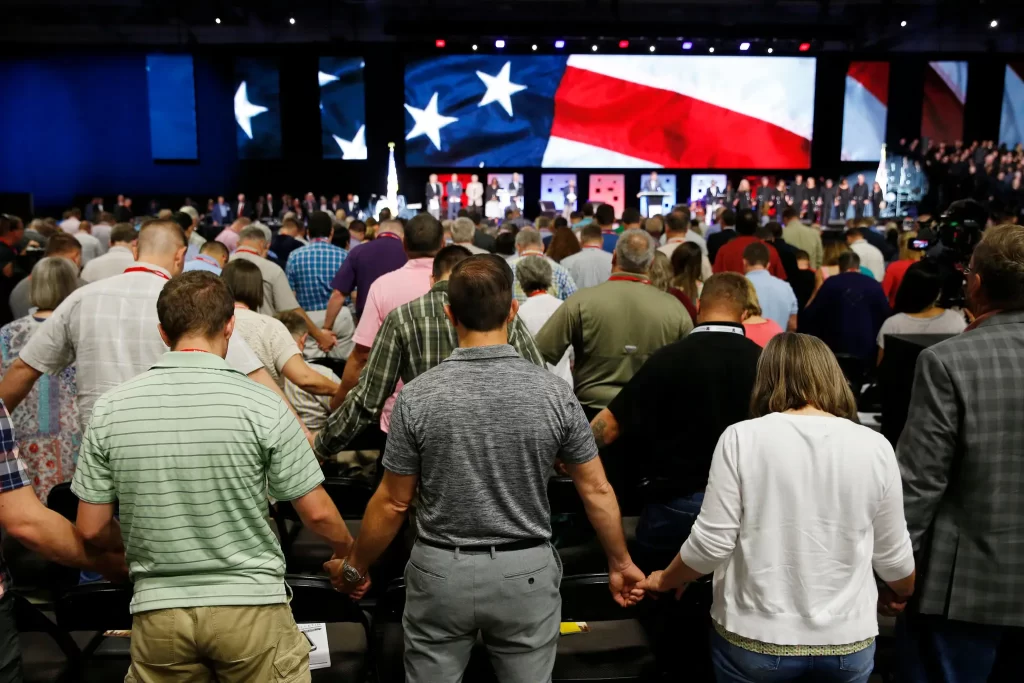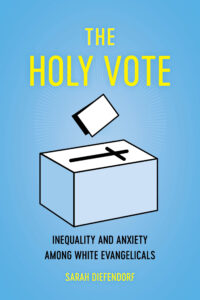Worried White Evangelicals
An excerpt from "The Holy Vote: Inequality and Anxiety Among White Evangelicals"

(Image source: Vernon Bryant via Associated Press)
The following excerpt comes from Sarah Diefendorf’s book The Holy Vote: Inequality and Anxiety Among White Evangelicals. The book explores the concerns facing White Evangelicals at a large congregation in the Pacific Northwest and how they are responding to cultural changes.
This excerpt comes from the book’s first chapter, “Good and Godly in Trump’s America.”
***
On January 22, 2017, the Sunday morning after the inauguration of President Donald Trump, a pastor at a predominantly White evangelical megachurch in the Pacific Northwest looked out onto his congregation with weary eyes. Two large screens on either side of the stage displayed a close up of his face as he began speaking. Pastor Dave started his sermon: “In the midst of this broken world, I keep envisioning one thing: our church is on the operating table.”
 Pastor Dave’s words suggest a level of vulnerability that we do not often associate with White evangelicals in the United States, especially following the 2016 election of Donald Trump. The pastor’s opening statement acknowledges a broken world, but also implies that perhaps the church is part of that brokenness and needs to be repaired too. Pastor Dave elaborated on his first thoughts with, “We are living in a broken world. Sometimes the corrupt is all we see. The election cycle did not help with that!” Some people in the room of 500 or so congregants at this place I call Lakeview Church laughed, and others nodded along. “Those presidential debates were messy…but the world is not divided into good and evil.”
Pastor Dave’s words suggest a level of vulnerability that we do not often associate with White evangelicals in the United States, especially following the 2016 election of Donald Trump. The pastor’s opening statement acknowledges a broken world, but also implies that perhaps the church is part of that brokenness and needs to be repaired too. Pastor Dave elaborated on his first thoughts with, “We are living in a broken world. Sometimes the corrupt is all we see. The election cycle did not help with that!” Some people in the room of 500 or so congregants at this place I call Lakeview Church laughed, and others nodded along. “Those presidential debates were messy…but the world is not divided into good and evil.”
On this cold January day, the otherwise usually upbeat and smiley pastor seemed distracted and concerned. The 52-year-old White pastor continued his sermon and told his congregation that as a result of the brokenness of the world, he believes that Christians are suffering. Pastor Dave suggested to his congregation that they need to work through this suffering, and learn to respond to it not with ugliness, anger, bitterness, or madness, but “to react in a godly way.” Pastor Dave bowed his head and exited the stage.
Pastor Amy replaced Pastor Dave on the large stage. Pastor Amy is an Associate Pastor at Lakeview church. This job title includes assisting Pastor Dave, as the Lead Pastor, in religious services and other daily operations of the church. Pastor Amy is a 35-year-old White woman and mother whose young children would often accompany her on stage. This morning, however, Pastor Amy walked slowly to the front of the stage with two heavy, large green buckets. Pastor Amy lifted each of the two buckets up onto a stool, and the cameras zoomed in on the buckets, bringing them, along with the liquid in each of them, into focus on the screens at the back of the stage. Pastor Amy was wearing a wireless headset and microphone, barely visible under her blonde bob. Pastor Amy raised a large yellow sponge in the air and asked the congregation to identify the object in her hand. When they responded accordingly, Pastor Amy asked, “How do we find out what is inside the sponge?” Before the crowd responded again Pastor Amy excitedly yelled “Squeeze it!”
Pastor Amy dunked the sponge in the bucket of dark colored water and then removed it, squeezing it over the bucket for everyone to see. The camera zoomed in on her hands. Pastor Amy held the sponge as black liquid flowed from it. She said, “This is you. We don’t like it. This is what the world does when it is hurt or pressed.”
Pastor Amy then dipped the sponge in the bucket of clear water and held it up to the crowd before squeezing it again and said, “But here is our challenge. When you’re pressed this is what happens. When you’re pressed it is rivers of living water that come forth. It’s not the suffering that gets us noticed, but how we react.” Clear water dripped down Pastor Amy’s arms as she continued to hold the sponge out above her. The worship team started to quietly play a new song on the stage behind her, and Pastor Amy joined in with the lyrics. She chanted, “I’m trading my sorrows. I’m trading my shame. I’m laying them down for the joy of the Lord…” as she vigorously squeezed the remaining clear, or “living” water out of the sponge for all in the room to see.
Pastor Dave returned to the stage to explain the meanings of the demonstrations to the congregation. Pastor Dave turned Pastor Amy’s elaborate and metaphorical demonstration into a clearly translated lesson for all watching: that they all need to learn to respond to their suffering without letting any ugliness show.
During the two years I spent conducting research at Lakeview Church, it became quite clear that “ugly” was a stand in for being marked as racist, sexist, and/or homophobic. Since the emergence of the culture wars in the United States in the 1970s, White evangelicals have come to political power and exuded great cultural influence through battles that privilege and protect the interests of White Christians, and most often White Christian men. Indeed, the lived experiences of White Christian men and women are often synonymous with, and the default category for what is understood to be American (Marti 2020). Now, religious affiliation is declining across the United States. Younger generations feel more abstract and unknown than ever as the social landscape shifts dramatically with the legalization of same-sex marriage, the Black Lives Matter movement, and the #MeToo movement, to name a few. The suffering the church perceives is directly tied to the status loss around White Christian manhood, and what it might mean for their longstanding cultural projects if many in the United States are unwilling to accept these identities as a default experience and, perhaps even worse for the church, unwilling to support the organizations that continue to protect these identities as a top priority.

(Image credit: Angela Hsieh)
Three months prior to Pastor Dave’s sermon, Donald Trump and Hillary Clinton engaged in three presidential candidate debates that quickly became known for their unprecedented hostility. The New York Times referred to the debates as a “90-minute spectacle of character attacks.” Clinton referenced the leaked 2005 tape in which Trump referred to his ability to grope women because of his fame. Trump repeatedly brought up accusations that President Bill Clinton was abusive towards women, and that Hillary Clinton was also responsible for attacking those same women. Trump said, on air, that Hillary Clinton had “tremendous hate in her heart” and infamously referred to her as a “nasty woman,” which became the rallying cry and self-identification for many who organized against Trump. In her book a year later, Hillary Clinton referred to the debates as experiences in which her “skin crawled.” Pastor Dave, and many at Lakeview Church acknowledge the “messiness” of those debates while appearing to avoid taking a side. For a group of people who believe quite strongly in the binaries of sinner/savior, and heaven/hell, they recognize that, at the intersections of their religious beliefs, political beliefs, and own perceived need for change and growth, thinking in binary terms, or, in this case, “good and evil” doesn’t really work. Instead, Pastor Dave, and Lakeview Church, see themselves in the messiness of those debates.
How do White evangelicals reconcile a need to grow and retain members in a rapidly changing social environment in which their beliefs, and by extension, their own sense of self, might be understood or labeled as “ugly?” What does it mean to react to this perceived suffering in a way that is, according to pastors Dave and Amy, godly and good, and what needs to happen on the metaphorical operating table for this to happen? How the church wrestles with these questions and navigates their responses are at the heart of this book.
This book documents the vulnerability, anxiety, and confusion that White evangelicals profess as they work to recreate themselves as good and godly, and to avoid being marked as ugly. I show how White evangelicals negotiate their personal beliefs around questions of gender, the family, race, and sexuality alongside the larger goals of the church of which they are a part. This book uncovers the ways in which a mega-church and its congregants seek to grow their membership, and, by logical extension, hold onto their cultural status. I illustrate the ways in which these goals work in tandem with continued White evangelical support for conservative politics, a longstanding relationship that continues to shape the social, cultural, and political landscape of the United States.
***
I entered Lakeview Church for the first time in late Fall 2015, with the goal of documenting the ways in which White evangelicals were debating questions related to gender and sexuality, especially after the federal legalization of same-sex marriage in June of 2015. However, in the two years I spent at Lakeview Church, the political landscape shifted around me.
On November 8th, 2016, a year into my fieldwork, I found myself among those who reportedly voted Donald Trump into office. I was already documenting the daily life, rituals, and debates of Lakeview Church, many of which were related to gender, sexuality, the family, and questions about the state of the church in a nation perceived to be in a cultural moment of great upheaval and change. The goals of my initial research project that brought me to Lakeview, then, are different, and smaller, than the goals of this book. But they are connected.
White evangelicals are willing to work to change with the times in an effort to uphold their cultural relevance, especially around questions and beliefs related to gender, sexuality, and the White family. However, these changes come with increased anxiety and feelings of confusion and resentment. And these changes often reflect the goals of the church instead of the concerns for the livelihood of others, as church members and the organizations of which they are a part work to reconcile an ugly past while appealing to younger generations for a more sustainable future as a church.
To both illustrate and complicate this idea of change among White evangelicals, this book is oriented around a concept I call the imagined secular. I find that evangelicals at Lakeview talk about a range of liberal projects: topics like feminism, trans rights, reproductive justice, “deviant” sexuality, and the Black Lives Matter movement. The imagined secular encapsulates what White evangelicals imagine these liberal projects to be and shapes their responses to them. Importantly, the imagined secular holds the feelings associated with these cultural changes in the United States as the church seeks to respond to and understand their own beliefs in relation to these topics. Conversations, debates, and concerns about the imagined secular occur among members in small groups within the church and are openly discussed by the pastoral team in Sunday sermons. These conversations encapsulate the very messiness to which Pastor Dave alludes, and they also show the church’s proverbial hand, as the content of these debates identify what the church thinks they need to engage with to be understood as good. In order to not be understood, or marked, as sexist, the church needs to talk about feminism. To avoid the label of racist, they need to talk about Black Lives Matter. And to no longer be the homophobes, the church needs to reconcile its position in response to the federal legalization of same-sex marriage.
The White evangelical church is facing dual projects: it needs to continue to grow its membership, and it needs to work to grow during a time in which rapid cultural shifts are illuminating the inequalities that form the pillars on which the church is built. In an effort to accomplish both of these intertwined goals—to appear welcoming and increase membership among younger generations—the church provides a space for the messy, varied responses to the components of the imagined secular world. However, I document the ways in which the church also engages in a bounded welcoming of components of the imagined secular: the church entertains conversations about feminism, Black Lives Matter, and same-sex marriage, but Lakeview Church is an organization governed by hierarchies of gender, race, and sexuality; as such, the church engages with the imagined secular as an organization in a way that allows for (and really, encourages) inequalities to endure. How they respond to the imagined secular sheds light on the ways in which conservative politics endure even in the midst of engagement with these mass cultural movements and shifts.
This book documents how the church and its congregants claim feminism as part of the church’s beliefs while upholding gendered inequalities, how they reconcile and also reinforce White nationalist tendencies with the need to now reach across racial lines, and how evangelicals retain a privileged position around reinforcements of a heterosexual Christian family while jettisoning some of their former associations with homophobia. The church is finding a way to respond to the “suffering” that they perceive, and they are doing so, in line with the advice of Pastor Amy, without letting their “ugliness” show. But the individual engagement with the imagined secular reflects what I call an instrumental acceptance and forced excitement of these cultural shifts, paying lip service to the ideas and ideals that challenge the foundations of the church while also simultaneously retaining power central to the intersections of whiteness, Christianity, masculinity and heterosexuality.
In Trump, White evangelicals found a politician who could help them with this project, someone who could do the ugly work for them to maintain the status quo, halt progressive change and defend their faith while they continue to wrestle with a host of questions about their collective identity. The evangelicals at Lakeview Church did not necessarily vote for Donald Trump because of what he stands for. Rather, in many ways, Trump symbolizes his own type of wall that can hold the imagined secular at bay while the church regroups during a period of time in which they feel as though they are quickly losing cultural sway, especially among younger generations. Indeed, to Make America Great is to uphold a history of white supremacy and Christian nationalism, and to Keep America Great is to ensure that no one else receives access to the privileges long afforded White Christian Americans. Trump and his policies can publicly enforce what many White evangelicals would rather support in private. Trump represented one politician ready to support and manifest a White evangelical political and cultural project, but he is not the first nor the last.
Lakeview Church is located in the Pacific Northwest; as such, this research moves the focus on White evangelical support for Trump out of the geographic South—out of the working class, disillusioned communities who voted for him, as Arlie Hochschild documents, because they feel they have lost their spot in line for the American Dream (2016). Instead, this research centers those who embody the American Dream, and also voted for Trump. I investigate the “coastal elites”: the middle – and upper-middle-class suburban White evangelicals who live in one of the areas of the United States with the best quality of life, and who don’t want to lose it. This work expands our understandings of the enduring relationship between White evangelism and conservative politics by asking these questions in an area of the country where such a relationship is often presumed irrelevant.
Sarah Diefendorf is a visiting scholar at Indiana University.
***
Interested in more on this topic? Check out episode 34 of the Revealer podcast: “Evangelicals’ Anxieties and Their Politics”